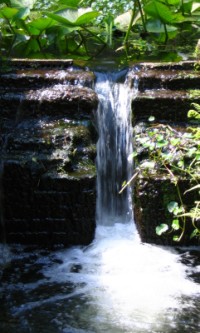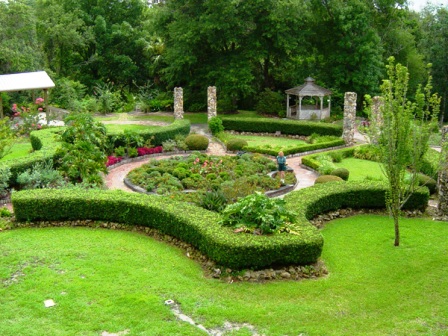Discover Florida Nature
It's time to explore the natural Florida


|
|
|
|
|
 Florida
has been shaped geographically and culturally by water and Ravine State
Gardens is representative of the never-ending shaping that occurs. A
steep ravine was created by water flowing from beneath the sandy ridges
that flank the west shore of the St. Johns River. As time passed, the
slopes of the ravine were colonized by grasses, shrubs and trees.
Located in northwest Florida, in Palatka Florida, Ravine Gardens State
Park is a crater where you can look down into and see streams and a
variety of plants and wildlife. The diversity of flora provides cover
and sustenance for a variety of small mammals and birds.
Peregrine falcons are known to visit here
during their annual migrations. Florida
has been shaped geographically and culturally by water and Ravine State
Gardens is representative of the never-ending shaping that occurs. A
steep ravine was created by water flowing from beneath the sandy ridges
that flank the west shore of the St. Johns River. As time passed, the
slopes of the ravine were colonized by grasses, shrubs and trees.
Located in northwest Florida, in Palatka Florida, Ravine Gardens State
Park is a crater where you can look down into and see streams and a
variety of plants and wildlife. The diversity of flora provides cover
and sustenance for a variety of small mammals and birds.
Peregrine falcons are known to visit here
during their annual migrations.The 59 acre gardens were created in a natural steephead ravine by the City of Palatka, local citizens, the Federal Emergency Relief Administration (FERA), the Federal Works Project Administration (WPA and the Civil Works Administration (CWA) in the 1930’S. Described in the 1934 Florida Municipal Record as the "Nations Outstanding Civil Works Administration. project," the 59 acre ravines were planted with over 95,000 azaleas including 64 varieties, 11,000 palm trees and more than 250,000 ornamental plants. The gardens were maintained by the City of Palatka until the park was deeded to the State of Florida in 1970. One of nine Florida state parks with New Deal Era structures, Ravine Gardens is the only park with a formal designed landscape. The extensive fieldstone terraces, rock gardens and massive cypress building construction is typical of the era. The Court of States and 64 foot obelisk dedicated to Franklin D. Roosevelt is located near the park entrance. A 1.8-mile paved road winds around the ravine, offering motorists and bicyclists a view of the gardens. The garden's peak flowering period is azalea season, late January to April. Much of the original landscaping still exists as formal gardens and an extensive trail system. The gardens in this 82 acre park were established in the 1930s, and camellias and azaleas were extensively planted to add their color in the spring, when the dogwoods are in bloom. An annual azalea festival the first week in March features guided tours. Among other attractions in this quiet, restful environment are a footbridge crossing the ravine, a water lily pond, two pure spring boils and five picnic areas. A fitness trail meanders through the gardens, giving you up close views to the lush growth found through out the gardens.  The
area of Palatka was once the domain of the
Timucuan nation, two
tribes of which existed in the Palatka region under chiefs Saturiwa and
Utina. They fished bass and mullets, or hunted deer, turkeys,
bear and
opossum. Others farmed beans, corn,
melons, squash and tobacco. But war and disease devastated the tribes.
Florida would then be taken over by the
Seminole, who called the location "Pilatka", a Seminole term meaning
“crossing over,” or “cows’ crossing.” Palatka was the southernmost point
on the river that Here the St. Johns
River narrows and begins a shallower, winding course upstream to
Lake George and Lake Monroe. On an expedition in April 1774 William
Bartram, a British Botanist, wrote of finding an Indian village on the
site of present day Palatka. The village included a large cultivated
orange grove and several hundred acres of corn, potatoes, beans, squash,
melons and tobacco. The
area of Palatka was once the domain of the
Timucuan nation, two
tribes of which existed in the Palatka region under chiefs Saturiwa and
Utina. They fished bass and mullets, or hunted deer, turkeys,
bear and
opossum. Others farmed beans, corn,
melons, squash and tobacco. But war and disease devastated the tribes.
Florida would then be taken over by the
Seminole, who called the location "Pilatka", a Seminole term meaning
“crossing over,” or “cows’ crossing.” Palatka was the southernmost point
on the river that Here the St. Johns
River narrows and begins a shallower, winding course upstream to
Lake George and Lake Monroe. On an expedition in April 1774 William
Bartram, a British Botanist, wrote of finding an Indian village on the
site of present day Palatka. The village included a large cultivated
orange grove and several hundred acres of corn, potatoes, beans, squash,
melons and tobacco. In 1822, a ferry was begun between Palatka and St. Augustine and an improved road was built between Palatka and Alachua. In December 1835, Seminoles attacked and burned Palatka and the white settlers from the entire St.Johns River valley fled to the safety of St. Augustine. During the Civil War the Union forces occupied the town after federal gunboats gained control of tile St. Johns River, but this period had no major impact on the community. 1865 to 1895 marks the golden age of Palatka, a time when Palatka rivaled Jacksonville as the major port on the St. Johns. By 1885, seven steamboat lines operated out of Palatka, including Hubbard Hart's Ocklawaha River Line and the Charleston, Savannah Line of Ocean Steamers. By the late 1870s the wharves extended across the entire riverfront with as many as forty ships waiting in the harbor to load or unload their cargoes. |
|
|
Ravine Gardens State Park Florida
Located in northwest Florida, in Palatka Florida, Ravine Gardens State Park is a crater where you can look down into and see streams and a variety of plants and wildlife. The diversity of flora provides cover and sustenance for a variety of small mammals and birds. Peregrine falcons are known to visit here during their annual migrations.
If you are planning on visiting Ravine Gardens State Park, make sure you go when the azaleas are blooming between the end of January until mid March. The 59 acre ravines were planted with over 95,000 azaleas including 64 varieties, 11,000 palm trees and more than 250,000 ornamental plants as part of the Federal Works Project in the 1930's. An annual azalea festival the first week in March features guided tours. Among other attractions in this quiet, restful environment are a footbridge crossing the ravine, a water lily pond, two pure spring boils and five picnic areas. A fitness trail meanders through the gardens, giving you up close views to the lush growth found through out the gardens.
Written by: Floridian Nature
Ravine Garden State Park
Date published: 10/23/2013
3 / 5 stars
|
|